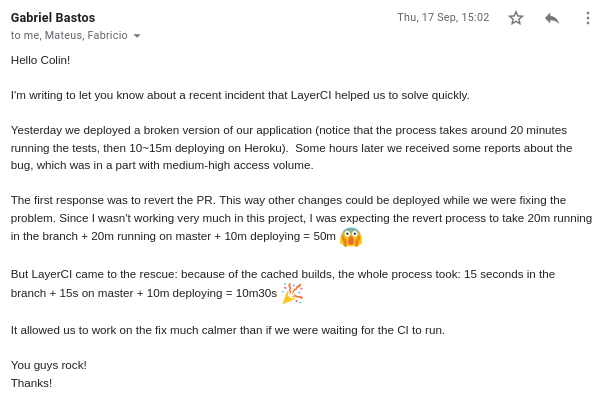
BxBlue is a B2C FinTech company. It's the leading marketplace for personal borrowers in Brazil.
What is BxBlue?
BxBlue is a B2C FinTech company. It's the leading marketplace for personal borrowers in Brazil. Techcrunch reports that payroll-secured loans form a $40B market in Brazil alone. Since their inception in 2017, the BxBlue team have changed the nature of borrowing by making loan information available online.
We had the pleasure of working with the CTO of BxBlue, Fabricio B. What stood out about Fabricio as a leader was his lookout for the best possible experience for his software development team. A common thread we’ve noticed in high growth technology companies is their technical leader's ability to create collaboration opportunities to continue to inspire their team. As the saying goes, "people don't quit jobs, they quit bosses."
The Challenge:
The top DevOps challenge BxBlue faced prior to using webapp.io was the long waiting period their development team faced for Continuous Integration (CI). They have a complex web application with a thorough test suite. Bypassing these test pipelines was not an option, and their team had tried multiple off-the-shelf CI/CD solutions in pursuit of the fastest and most flexible option available.
In addition, a second challenge they wanted to tackle was being able to continue to scale their development team at the rate that they want, and not allowing queuing or wait times to slow their team down.
Given this, they were ready for a better DevOps solution on the market.
The Process:
After conversations with Fabricio, we had the opportunity to work closely with two of BxBlue’s software developers, Gabriel B. and Mateus F. to implement webapp.io. An important part of webapp.io team’s rollout process is to provide implementers with the support resources they need to feel confident throughout the process.
After a full installation and months of using webapp.io, we received an awesome email from Gabriel:

It was an exciting day for the BxBlue team! Below is a summary of what we learned through helping them transform their developer experience.
Before webapp.io:
- The team was using Semaphore CI as their CI/CD platform
- Polyrepo infrastructure
- Tech stack: Ruby on Rails, Mongo, PostgreSQL, Docker, and Redis
- Full list of challenges:
- Increasing operating costs for slower builds, in particular CI wait times
- Wanting to scale hiring development team in a sustainable way
- A slow Docker experience and Ruby on rails experience
- Limited test runs allowed for CI solution that often creating queuing
After using webapp.io:
- Tech stack: Ruby on Rails, Mongo, PostgreSQL, Docker, and Redis
- Polyrepo infrastructure
- Testing speeds were improved from ~50m per commit to ~10min per commit for a team of 20+ developers for the entire pipeline.
- The developer team continues to receive dedicated technical support even after a full installation to help them train and onboard new developers.
- Full list of solutions:
- webapp.io's caching feature allows bypassing of setup steps based on the files read to avoid unnecessary test runs and save time
- Developer team scaled at the rate that the company wanted to
- A faster CI experience for the same stack, from ~25 mins per commit to ~30 seconds per commit. The overall pipeline would take from ~50 mins per commit down to ~10.5 mins per commit.
- Per developer seat pricing made webapp.io’s solution affordable and predictable.
Why did they choose webapp.io?
From the perspective of the CTO:
“We're always eager to try things that can improve our work. Trying webapp.io was a no-brainer, the team is amazing and there was a lot of excitement on our part to give it a go. But we stayed because it's clearly the best option. Not only it works like any other CI, ensuring things are not breaking. But in the end, it was simple to integrate and keep things up to speed, and it greatly reduced our waiting times. This means less anxiety of the team, faster feedback of the code, and an overall increase in happiness.” - Fabricio Buzeto
From the perspective of a implementation software developer on the team:
“First we tried as test users, as we were testing we could see the potential and how it could help us in our pipeline. I think we have some objective factors that helped us to make our decision to migrate from Semaphore to webapp.io: queue by developer, cache in some stages that lead us to faster builds, customer support, and cost.” - Mateus Luiz Freitas
